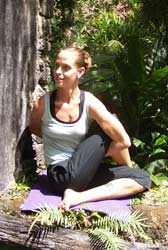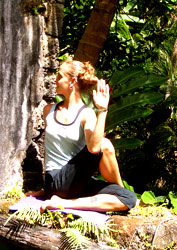 |
|
| Site Areas |
store | | | articles | | | forums | | | studios | | | vacations |
| yoga | massage | fitness | wellness | readings | ask the expert | |
Ardha MatsyendrasanaYogiSource.com Staff©Yoga People, LLC 2017 Pronunciation: Ardha Matsyendrasana (ARE-duh MOT-see-en-DRAWS-ahna) In Sanskrit, ardha means half. Matsyendra was a legendary sage in yoga called the King of the Fishes. The legend says that Shiva went to an island with his consort Parvati. The fish listened near Shiva and learned yoga. Shiva realized this and blessed the fish by sprinkling water on it, and then it assumed form as Lord of the Fishes, or Matsyendra who is said to have spread the wisdom of yoga.
Ardha Matsyandrasana I This pose rotates the spine making it flexible. It is also called a half spinal twist and is done from a seated position. Other twists are also named after sages in yoga. Technique: Sit on your mat in Dandasana with your legs extended in front of you. Bend your left leg and position your left foot on its side beneath you. The outer edge of the foot should be on your mat while you sit on the inner edge of the horizontal foot. Place your left sit-bone on the inner left heel and the right sit-bone on the outer ball of the big toe of the left foot. If you cannot yet assume this position use a folded blanket on top of the left foot as a prop. The blanket should be folded so that it is thick enough to so that you can sit comfortably with equal weight on eac sit-bone.. If the pose creates pain in the left knee, try rolling a wash cloth tightly so that it forms a cylinder and positioning it high up in the inner knee as you fold the leg. This prop will often make needed room in the joint and can allow this and other poses with bent legs to be assumed in a pain-free fashion. The right leg should now be bent and the right foot positioned on the floor outside the left thigh with the knee pointed up toward the ceiling. Attempt to keep equal weight on the insde and the outside of the right foot. Your spine should be elongated during this pose. In the pose you twist the torso to the right while maintaining an erect extended spine. Be aware of keeping equal weight on each of your sit-bones and of keeping the shoulders at the same height throughout. This will help you to maintain the proper spinal orientation. In both the preliminary pose and in the final pose you use your arm to help deepen the stretch. In the preliminary version of the pose your left arm is bent and the left elbow is placed on the outside of the outer crook of the bent right leg. The hand is palm upward. Press with the arm to deepen the spinal twist. See the photo for positioning details. In the final pose bring your left armpit over the bent right leg and bend the left arm back. Then swing the right arm behind you and try to clasp the left hand or if possible wrist with the right hand. If you cannot yet reach the left hand with the right use a strap or yoga belt. Hold onto the belt with the left hand and allow it to lie on the floor behind you. Clasp it with the right hand and work the hand up the belt until you the right hand is as close as possible to the left hand. In both the preliminary pose and the final pose turn the head and gaze to the left and focus on twisting the torso to the right around your extended and elongated vertical spine.
Exhale and twist more deeply. As you inhale, extend the spine taller and more erect. Continue to work with your breath twist more deeply with each exhalation. Use long breaths. Think of lifting on the inhale and softening the belly on the exhale as you twist more deeply. Attempt to hold the pose for 30 seconds to one minute on each side. Come out of the pose and change sides. The legs change positions and you twist to the opposite side. Remember to twist toward the opposite knee that is raised. Use your elbow or clasped arms to deepen the twist. Remember to use the exhaling and inhaling advice given. Take it slow and easy-do not hold the breath and do keep it even. Release the pose and rest in a seated position. Beginner’s Tip: This pose can teach you how to have a full and rhythmic breath when under stress. Use this wisdom to calm the body in the twist and it can extend to situations off of the mat in your life. Benefits: This pose contributes to emotional health and well-being. For physical health, it brings fresh blood circulation to the vital organs and especially will benefit the kidneys, stomach, small intestines, liver and gall bladder. The twist clears out toxins in the internal organs of the body. Ardha Matsyendrasana I stimulates digestion and is therapeutic for constipation and dyspepsia. The practice of this pose may reduce abdominal girth by working the abdominal muscles. Lungs are encouraged to breathe more deeply. The spine of the body benefits from this yoga position. Muscles along spine are stretched making a flexible and youthful spine. Increased circulation for spinal nerves, and thus it contributes to well-being of the entire body. Health and vitality of whole body is given. Contraindications and Cautions: Don’t do the pose if you have a back or spine injury. Do the pose under supervision of a teacher with experience if you have mild back pain or sciatica. Be cautious and listen to your body in any case as you should with all yoga poses. Don’t do this pose if you have hyperthyroidism as it can be stimulating. Don’t do if you have a hernia or a peptic ulcer. Avoid the pose in menstruation and pregnancy. Special thanks to Victor Oppenheimer for his yoga expertise and editing of this article. Copyright 2007 Yoga People LLC All Rights Reserved
|
| about us | contact | privacy | site map | careers | |

|
|

